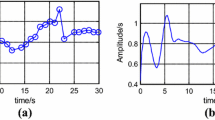Abstract
Sleep staging is important for assessing sleep quality. So far, many scholars have tried to achieve automatic sleep staging by using neural networks. However, most researchers only perform sleep staging based on artificial neural networks and their variant models, which can not fully mine and model the bio-electrical signals. In this paper, we propose a new hybrid spiking neural network (HSNN) model for automatic sleep staging. Specifically, we use a spiking neural network to classify sleep EEG signals. In addition, we adopt a hybrid macro/micro back propagation algorithm, aiming to overcome the limitations of existing error back propagation methods for spiking neural network. In order to verify the effectiveness of HSNN, we evaluate it on the public sleep dataset ISRUC-SLEEP (Institute of Systems and Robotics, University of Coimbra-Sleep). The results show that the proposed method achieves satisfactory performance on ISRUC-SLEEP.
Similar content being viewed by others
References
McCarley R W. Neurobiology of REM and NREM sleep. Sleep Med, 2007, 8: 302–330
Maind S B, Wankar P. Research paper on basic of artificial neural network. Int J Recent Innov Trend Comput Commun, 2014, 2: 96–100
Chambon S, Galtier M N, Arnal P J, et al. A deep learning architecture for temporal sleep stage classification using multivariate and multimodal time series. IEEE Trans Neural Syst Rehabil Eng, 2018, 26: 758–769
Supratak A, Dong H, Wu C, et al. DeepSleepNet: a model for automatic sleep stage scoring based on raw single-channel EEG. IEEE Trans Neural Syst Rehabil Eng, 2017, 25: 1998–2008
Jia Z Y, Lin Y F, Wang J, et al. Multi-view spatial-temporal graph convolutional networks with domain generalization for sleep stage classification. IEEE Trans Neural Syst Rehabil Eng, 2021, 29: 1977–1986
Cai X Y, Jia Z Y, Tang M F, et al. Brainsleepnet: learning multivariate EEG representation for automatic sleep staging. In: Proceedings of IEEE International Conference on Bioinformatics and Biomedicine (BIBM), 2020. 976–979
Jia Z Y, Lin Y F, Zhang H J, et al. Sleep stage classification model based ondeep convolutional neural network. J ZheJiang Univ (Eng Sci), 2020, 54: 1899–1905
Jia Z Y, Lin Y F, Wang J, et al. Salientsleepnet: multimodal salient wave detection network for sleep staging. 2021. ArXiv: 2105.13864
Jia Z Y, Cai X Y, Zheng G X, et al. SleepPrintNet: a multivariate multimodal neural network based on physiological time-series for automatic sleep staging. IEEE Trans Artif Intell, 2020, 1: 248–257
Jia Z Y, Lin Y F, Wang J, et al. Graphsleepnet: adaptive spatial-temporal graph convolutional networks for sleep stage classification. In: Proceedings of the 29th International Joint Conference on Artificial Intelligence, 2020. 1324–1330
Su Y, Hu B, Xu L X, et al. EEG-data-oriented knowledge modeling and emotion recognition. Chin Sci Bull, 2015, 60: 1002–1009
Jin W Y, Wang A, Ma J, et al. Effects of electromagnetic induction and noise on the regulation of sleep wake cycle. Sci China Tech Sci, 2019, 62: 2113–2119
Zhao W R, Li C Y, Chen J J, et al. Insomnia disorder and hyperarousal: evidence from resting-state and sleeping EEG. Sci Sin Vitae, 2020, 50: 270–286
Zhang Z M, Wang H P, Xu F, et al. Complex-valued convolutional neural network and its application in polarimetric SAR image classification. IEEE Trans Geosci Remote Sens, 2017, 55: 7177–7188
Chriskos P, Frantzidis C A, Gkivogkli P T, et al. Automatic sleep staging employing convolutional neural networks and cortical connectivity images. IEEE Trans Neural Netw Learn Syst, 2020, 31: 113–123
Phan H, Andreotti F, Cooray N, et al. SeqSleepNet: end-to-end hierarchical recurrent neural network for sequence-to-sequence automatic sleep staging. IEEE Trans Neural Syst Rehabil Eng, 2019, 27: 400–410
Phan H, Andreotti F, Cooray N, et al. Automatic sleep stage classification using single-channel EEG: learning sequential features with attention-based recurrent neural networks. In: Proceedings of the 40th Annual International Conference of IEEE Engineering in Medicine and Biology Society (EMBC), 2018. 1452–1455
Liu Y H, Wang X J. Spike-frequency adaptation of a generalized leaky integrate-and-fire model neuron. J Comput Neurosci, 2001, 10: 25–45
Schrauwen B, van Campenhout J. BSA, a fast and accurate spike train encoding scheme. In: Proceedings of International Joint Conference on Neural Networks, 2003. 2825–2830
Bohte S M, Kok J N, La Poutré H. Error-backpropagation in temporally encoded networks of spiking neurons. Neurocomputing, 2002, 48: 17–37
Lee J H, Delbruck T, Pfeiffer M. Training deep spiking neural networks using backpropagation. Front Neurosci, 2016, 10: 508
Jin Y Y Z, Zhang W R, Li P. Hybrid macro/micro level backpropagation for training deep spiking neural networks. In: Proceedings of Advances in Neural Information Processing Systems, 2018. 7005–7015
Huh D, Sejnowski T J. Gradient descent for spiking neural networks. In: Proceedings of Advances in Neural Information Processing Systems, 2018. 1433–1443
Khalighi S, Sousa T, Santos J M, et al. ISRUC-sleep: a comprehensive public dataset for sleep researchers. Comput Method Programs Biomed, 2016, 124: 180–192
Sm I N, Zhu X, Chen Y, et al. Sleep stage classification based on EEG, EOG, and CNN-GRU deep learning model. In: Proceedings of the 10th International Conference on Awareness Science and Technology (iCAST), 2019. 1–7
Michielli N, Acharya U R, Molinari F. Cascaded LSTM recurrent neural network for automated sleep stage classification using single-channel EEG signals. Comput Biol Med, 2019, 106: 71–81
Jeon Y, Kim S, Choi H S, et al. Pediatric sleep stage classification using multi-domain hybrid neural networks. IEEE Access, 2019, 7: 96495–96505
Acknowledgements
This work was supported by Fundamental Research Funds for the Central Universities (Grant No. 2020YJS025) and partially supported by Zhejiang Lab’s International Talent Fund for Young Professionals.
Author information
Authors and Affiliations
Corresponding authors
Rights and permissions
About this article
Cite this article
Jia, Z., Ji, J., Zhou, X. et al. Hybrid spiking neural network for sleep electroencephalogram signals. Sci. China Inf. Sci. 65, 140403 (2022). https://doi.org/10.1007/s11432-021-3380-1
Received:
Accepted:
Published:
DOI: https://doi.org/10.1007/s11432-021-3380-1




